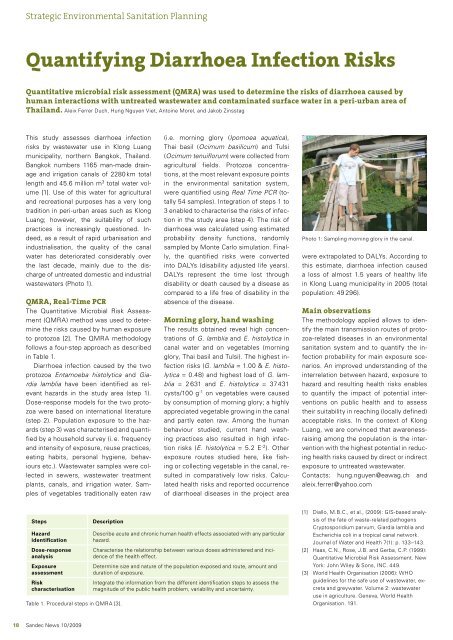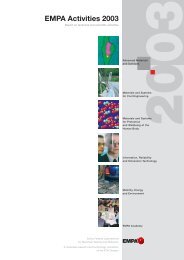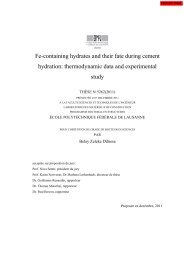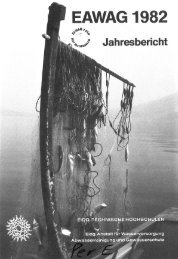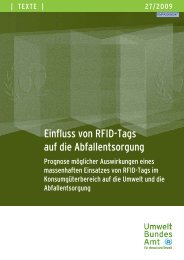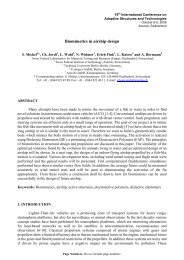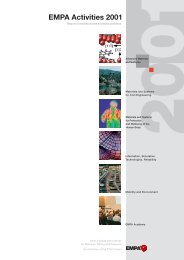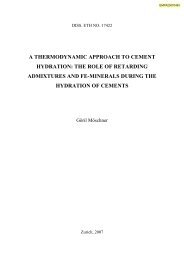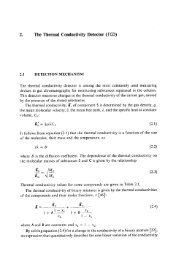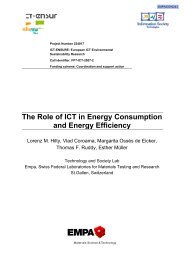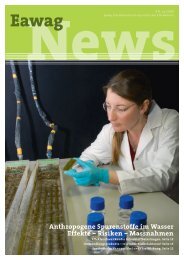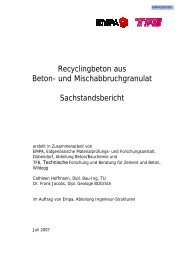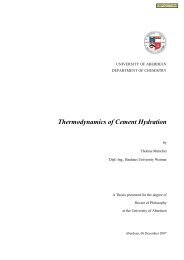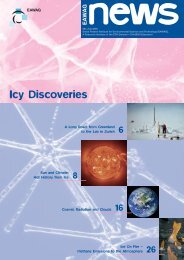Sandec - Eawag
Sandec - Eawag
Sandec - Eawag
Create successful ePaper yourself
Turn your PDF publications into a flip-book with our unique Google optimized e-Paper software.
Strategic Environmental Sanitation Planning<br />
Quantifying Diarrhoea Infection Risks<br />
Quantitative microbial risk assessment (QMRA) was used to determine the risks of diarrhoea caused by<br />
human interactions with untreated wastewater and contaminated surface water in a peri-urban area of<br />
Thailand. Aleix Ferrer Duch, Hung Nguyen Viet, Antoine Morel, and Jakob Zinsstag<br />
This study assesses diarrhoea infection<br />
risks by wastewater use in Klong Luang<br />
municipality, northern Bangkok, Thailand.<br />
Bangkok numbers 1165 man-made drainage<br />
and irrigation canals of 2280 km total<br />
length and 45.6 million m 3 total water volume<br />
[1]. Use of this water for agricultural<br />
and recreational purposes has a very long<br />
tradition in peri-urban areas such as Klong<br />
Luang; however, the suitability of such<br />
practices is increasingly questioned. Indeed,<br />
as a result of rapid urbanisation and<br />
industrialisation, the quality of the canal<br />
water has deteriorated considerably over<br />
the last decade, mainly due to the discharge<br />
of untreated domestic and industrial<br />
wastewaters (Photo 1).<br />
QMRA, Real-Time PCR<br />
The Quantitative Microbial Risk Assessment<br />
(QMRA) method was used to determine<br />
the risks caused by human exposure<br />
to protozoa [2]. The QMRA methodology<br />
follows a four-step approach as described<br />
in Table 1.<br />
Diarrhoea infection caused by the two<br />
protozoa Entamoeba histolytica and Giardia<br />
lamblia have been identified as relevant<br />
hazards in the study area (step 1).<br />
Dose-response models for the two protozoa<br />
were based on international literature<br />
(step 2). Population exposure to the hazards<br />
(step 3) was characterised and quantified<br />
by a household survey (i. e. frequency<br />
and intensity of exposure, reuse practices,<br />
eating habits, personal hygiene, behaviours<br />
etc.). Wastewater samples were collected<br />
in sewers, wastewater treatment<br />
plants, canals, and irrigation water. Samples<br />
of vegetables traditionally eaten raw<br />
Steps Description<br />
Hazard<br />
identification<br />
Dose-response<br />
analysis<br />
Exposure<br />
assessment<br />
Risk<br />
characterisation<br />
Table 1. Procedural steps in QMRA [3].<br />
1 <strong>Sandec</strong> News 10/2009<br />
(i.e. morning glory (Ipomoea aquatica),<br />
Thai basil (Ocimum basilicum) and Tulsi<br />
(Ocimum tenuiflorum) were collected from<br />
agricultural fields. Protozoa concentrations,<br />
at the most relevant exposure points<br />
in the environmental sanitation system,<br />
were quantified using Real Time PCR (totally<br />
54 samples). Integration of steps 1 to<br />
3 enabled to characterise the risks of infection<br />
in the study area (step 4). The risk of<br />
diarrhoea was calculated using estimated<br />
probability density functions, randomly<br />
sampled by Monte Carlo simulation. Finally,<br />
the quantified risks were converted<br />
into DALYs (disability adjusted life years).<br />
DALYs represent the time lost through<br />
disability or death caused by a disease as<br />
compared to a life free of disability in the<br />
absence of the disease.<br />
Morning glory, hand washing<br />
The results obtained reveal high concentrations<br />
of G. lamblia and E. histolytica in<br />
canal water and on vegetables (morning<br />
glory, Thai basil and Tulsi). The highest infection<br />
risks (G. lamblia = 1.00 & E. histolytica<br />
= 0.48) and highest load of G. lamblia<br />
= 2 631 and E. histolytica = 37431<br />
cysts/100 g -1 on vegetables were caused<br />
by consumption of morning glory; a highly<br />
appreciated vegetable growing in the canal<br />
and partly eaten raw. Among the human<br />
behaviour studied, current hand washing<br />
practices also resulted in high infection<br />
risks (E. histolytica = 5.2 E -2 ). Other<br />
exposure routes studied here, like fishing<br />
or collecting vegetable in the canal, resulted<br />
in comparatively low risks. Calculated<br />
health risks and reported occurrence<br />
of diarrhoeal diseases in the project area<br />
Describe acute and chronic human health effects associated with any particular<br />
hazard.<br />
Characterise the relationship between various doses administered and incidence<br />
of the health effect.<br />
Determine size and nature of the population exposed and route, amount and<br />
duration of exposure.<br />
Integrate the information from the different identification steps to assess the<br />
magnitude of the public health problem, variability and uncertainty.<br />
Photo 1: Sampling morning glory in the canal.<br />
were extrapolated to DALYs. According to<br />
this estimate, diarrhoea infection caused<br />
a loss of almost 1.5 years of healthy life<br />
in Klong Luang municipality in 2005 (total<br />
population: 49 296).<br />
Main observations<br />
The methodology applied allows to identify<br />
the main transmission routes of protozoa-related<br />
diseases in an environmental<br />
sanitation system and to quantify the infection<br />
probability for main exposure scenarios.<br />
An improved understanding of the<br />
interrelation between hazard, exposure to<br />
hazard and resulting health risks enables<br />
to quantify the impact of potential interventions<br />
on public health and to assess<br />
their suitability in reaching (locally defined)<br />
acceptable risks. In the context of Klong<br />
Luang, we are convinced that awarenessraising<br />
among the population is the intervention<br />
with the highest potential in reducing<br />
health risks caused by direct or indirect<br />
exposure to untreated wastewater.<br />
Contacts: hung.nguyen@eawag.ch and<br />
aleix.ferrer@yahoo.com<br />
[1] Diallo, M.B.C., et al., (2009): GIS-based analysis<br />
of the fate of waste-related pathogens<br />
Cryptosporidium parvum, Giardia lamblia and<br />
Escherichia coli in a tropical canal network.<br />
Journal of Water and Health 7(1): p. 133–143.<br />
[2] Haas, C.N., Rose, J.B. and Gerba, C.P. (1999):<br />
Quantitative Microbial Risk Assessment. New<br />
York: John Wiley & Sons, INC. 449.<br />
[3] World Health Organisation (2006): WHO<br />
guidelines for the safe use of wastewater, excreta<br />
and greywater. Volume 2: wastewater<br />
use in agriculture. Geneva, World Health<br />
Organisation. 191.


